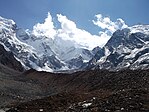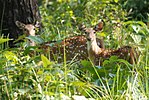Sudurpashchim Province
Sudurpashchim Province
सुदूर-पश्चिम प्रदेश | |
|---|---|
      Clockwise from top Saipal, Ghodaghodi Lake, Swamp deer at Shuklaphanta National Park, Badimalika Temple, Khaptad Lake, Api Himal | |
 Seal | |
 Location of Sudurpashchim Province | |
Divisions of Sudurpashchim Province | |
| Coordinates: 28°42′12″N 80°34′01″E / 28.70333°N 80.56694°ECoordinates: 28°42′12″N 80°34′01″E / 28.70333°N 80.56694°E | |
| Country | |
| Formation | 20 September 2015 |
| Capital | Godawari |
| Largest city | Dhangadhi |
| Districts | 9 |
| Government | |
| • Type | Self governing province |
| • Body | Government of Sudurpashchim Province |
| • Governor | Dev Raj Joshi |
| • Chief Minister | Trilochan Bhatta (CPN (Maoist Centre)) |
| • High Court | Dipayal High Court |
| • Provincial Assembly | Unicameral (53 seats) |
| • Parliamentary constituency | House of Representatives (16 seats) National Assembly (8 seats) |
| Area | |
| • Total | 19,515.52 km2 (7,534.98 sq mi) |
| • Rank | 6th |
| Population (2021) | |
| • Total | 2,711,270 |
| • Rank | 5th |
| • Density | 140/km2 (360/sq mi) |
| • Rank | 5th |
| Demonym(s) | Sudur Pashchimeli Nepali, Paschime Khasya |
| Time zone | UTC+5:45 (NST) |
| Geocode | NP-SE |
| Official language | Nepali |
| Other Official language(s) | 1. Doteli Khas 2. Tharu (Rana) |
| HDI | 0.478 (low) |
| Literacy | 63.48% |
| Sex ratio | 91.25 ♂ /100 ♀ (2011) |
| GDP | US$2.46 billion |
| GDP rank | 6th |
| Website | p7 |
Sudurpashchim Province (Nepali: सुदूरपश्चिम प्रदेश, Sudurpashchim Province) (Far-West Province) is one of the seven provinces established by the new constitution of Nepal which was adopted on 20 September 2015.[1] It borders the Tibet Autonomous Region of China to the north, Karnali Province and Lumbini Province to the east, and the India's Kumaon to the west and Uttar Pradesh to the south. The province covers an area of 19,515.52 km2 - about 13.22% of the country's total area. Initially known as Province No. 7, the newly elected Provincial Assembly adopted Sudurpashchim Province as the permanent name for the province in September 2018. As per a 28 September 2018 Assembly voting, the city of Godawari has been declared the capital of the Province.[2][3] The province is coterminous with the former Far-Western Development Region, Nepal. The three major cities in terms of population and economy are Dhangadhi, Bhimdutta (Mahendranagar), and Tikapur.[4]
History[]

Doti was an ancient kingdom in the far western region of Kumaon which was formed after the disintegration of the Katyuri Kingdom of Kumaon around the 13th century.[5] Doti was one of eight different princely states the Katyuri Kingdom was divided into eight for their eight prince's and became different independent kingdoms; Baijnath-Katyuri, Dwarahat, Doti, Baramandal, Askot, Sira, Sora, Sui (Kali Kumaon). Later on, the whole land between Ramganga on the west (Uttarakhand) and the Karnali on the east (which divides the far western region from other parts of Nepal), came under the Raikas after the origin of Raikas of Katyuris in Doti.[6] "Brahma Dev Mandi" at Kanchanpur District of Mahakali Zone was established by Katyuri king Brahma Dev.[7]
Before the announcement of new provinces in Nepal, the area of this province was known as Far-Western development region of Nepal. There were no changes made in this province when this province was made.
Raikas of Doti[]
Niranjan Malla Dev was the founder of Khas Doti Kingdom around the 13th century after the fall of the Katyuri Kingdom. He was the son of Last Katyuris of united Katyuris kingdom.[8]
Kings of Doti were called Raikas (also Rainka Maharaj).[9] Later on Raikas, after defeating the Khas Malla of Karnali Zone, were able to establish the strong Raikas Kingdom in Far Western Region and Kumaon which was Doti.
Mughal invasion[]
During the period of Akbar's rule in the 16th century, the Mughals had attacked the Raikas of Doti. They invaded Ajemeru, the capital of the Raika Kingdom. Ajemeru is now in Dadeldhura District of the far western region of Nepal. Hussain Khan, army chief of Akbar residing in Lucknow had led the attack. According to `Abd al-Qadir Bada'uni (c. 1540 - 1615), Indo-Persian historian during Mughal Empire, Mughal Army chief of Lucknow, Hussian Khan, lured by the wealth and treasures of the kingdom of the Raikas, wanted to plunder the region, this being the motive behind the assault, but they did not succeed.[10]
Conflict with Gorkha[]
The historic place of war between the Khas Doti Kingdom and Nepal (Khas Gorkha kingdom) during the period of Gorkha/Khas Expansion in 1790, according to the history of Nepal, is Nari-Dang, on the bank of the Seti River. The Dumrakot was the base of the Khas Doti Kingdom for fighting against the Own Khas Gorkhalis.
Khairgarh-Singhai State[]
Raja Deep Shahi was expelled from Nepal in 1790 A.D and on arriving at Terai of Oudh (now Lakhimpur Kheri District of Uttar Pradesh of India) he established Khairgarh-Singhai State in Khairigarh under British India.[11] Kanchanpur Praganna (present Kanchanpur and Kailali districts) was also the parts of his State or Zamindari. He succeeded in defeating the Banjaras rural of Khairigarh and establishing himself in that Pargana and in parts of Bhur. His state was merged with India In 1947 after Indian Independence.
Government and administration[]
The Governor acts as the head of the province while the Chief Minister is the head of the provincial government. The Chief Judge of the Dipayal High Court is the head of the judiciary.[12] The present Governor, Chief Minister and Chief Judge are Ganga Prasad Yadav(governor), Trilochan Bhatta (chief minister) and Yagya Prasad Basyal.[13][14] The province has 53 provincial assembly constituencies and 16 House of Representative constituencies.[15]
Sudurpashchim Province has a unicameral legislature, like all of the other provinces in Nepal. The term length of the provincial assembly is five years. The Provincial Assembly of Sudurpashchim Province is temporarily housed at the District Coordination Committee Hall in Dhangadhi.[16]

Administrative subdivisions[]
The province is divided into nine districts, which are listed below. A district is administrated by the head of the District Coordination Committee and the District Administration Officer. The districts are further divided into municipalities or rural municipalities. The municipalities include one sub-metropolitan city and 33 municipalities. There are 54 rural municipalities in the province.[17]
- Achham District
- Baitadi District
- Bajhang District
- Bajura District
- Dadeldhura District
- Darchula District
- Doti District
- Kailali District
- Kanchanpur District
Demographics[]
The province has a population of 2,552,517 which is 9.63% of the total population of Nepal. The population density is about 130 persons per square kilometer. The province has a population growth rate of 1.53%. The sex ratio is 912 males for 1000 females, with a total of 1,217,887 males and 1,334,630 females recorded in 2011. The urban population of the region is 1,504,279 (58.9%) and the rural population is 1,048,238 (41.1%).[18]
Ethnic groups[]
The Khas/Chhetri are the largest Native Indigenous group, making up 44.09% of the population. The Tharu are the second largest, making up 17.15%. Other Khas groups including Hill Brahmin, Kami, Thakuri, Damai, Sarki, Lohar and Sanyasi make up 11.90%, 7.22%, 4.40%, 2.56%, 1.67%, 1.17% and 1.01% of the population. There are some Magars (2.18%) as well.[19]
Languages[]
According to the 2011 census, 78.76% People Speak Varieties of Khas languages Such as, 30.22% of the population speak Khas Doteli, 29.71% Khas Nepali, 16.97% Tharu, 10.62% Khas Baitadeli, 5.57% Khas Acchami, 2.64% Khas Bajhangi and 0.89% Magar as their first language.[19]
The Language Commission of Nepal has recommended Dotyali and Tharu as official language in the province. The commission has also recommended Baitadeli, Achhami, and Bajhangi to be additional official languages, for specific regions and purposes in the province.[20]
Religion[]
Religion in Sudurpashchim Province
| Rank | District | Pop. | Rank | District | Pop. | ||||
|---|---|---|---|---|---|---|---|---|---|
 Bhimdatta |
1 | Dhangadhi | Kailali | 147,741 | 11 | Bhajani | Kailali | 51,845 |  Godawari |
| 2 | Bhimdatta | Kanchanpur | 104,599 | 12 | Bedkot | Kanchanpur | 49,479 | ||
| 3 | Godawari | Kailali | 78,018 | 13 | Shuklaphanta | Kanchanpur | 46,834 | ||
| 4 | Tikapur | Kailali | 76,984 | 14 | Mahakali | Kanchanpur | 39,253 | ||
| 5 | Ghodaghodi | Kailali | 75,586 | 15 | Purchaudi | Baitadi | 39,174 | ||
| 6 | Lamki Chuha | Kailali | 75,425 | 16 | Parshuram | Dadeldhura | 34,983 | ||
| 7 | Krishnapur | Kanchanpur | 56,643 | 17 | Dasharath Chand | Baitadi | 34,575 | ||
| 8 | Gauriganga | Kailali | 55,314 | 18 | Sanphebagar | Achham | 33,788 | ||
| 9 | Punarbas | Kanchanpur | 53,633 | 19 | Bungal | Bajhang | 33,224 | ||
| 10 | Belauri | Kanchanpur | 53,544 | 20 | Dipayal Silgadhi | Doti | 32,941 | ||
See also[]
References[]
- ^ "Nepal Provinces". statoids.com. Retrieved 21 March 2016.
- ^ "Prov 7 named Sudurpashchim amid objection from NC, RJP". The Himalayan Times. 28 September 2018. Retrieved 1 October 2018.
- ^ "Province 7 named Sudurpashchim, Godawari capital". The Kathmandu Post. 28 September 2018. Retrieved 1 October 2018.
- ^ "Nepal Provinces". www.statoids.com.
- ^ Dr.Y.S Kathoch, A New History of Uttarakhand; On Katyuri Dynasty "Around,13th Century Katyuri Dynasty established in Ranachulihat was broken into many sections" Doti was among them
- ^ Advin T. Atkinson; Gazetteer Hindi Edition (2003); He wrote (Page 274) Whole territory to the east of Ram gang was belongs to Raikas during the late 16th century.
- ^ Dr. Madam Chandra Bhatt; A New History of Uttarakhand (2006): " Champawat ke Chand Raja.
- ^ Dr. Y.S Kathoch; A New History of Uttarakhand(2006). Founder of Doti was Niranjan Mall Dev..
- ^ Badri Datt Pandey ; History of Kumaun (1937)
- ^ "Kumaon History". Thekumaonhills.com. 29 March 1947. Retrieved 4 June 2015.
- ^ [1][dead link]
- ^ "High Courts get their chief judges". Retrieved 27 April 2018.
- ^ "Trilochan Bhatta becomes Province 7 chief minister". The Himalayan Times. 16 February 2018. Retrieved 28 April 2018.
- ^ "President of Nepal administers oath to Chiefs of seven provinces | DD News". ddnews.gov.in. Retrieved 27 April 2018.
- ^ "CDC creates 495 constituencies". The Himalayan Times. 31 August 2017. Retrieved 27 April 2018.
- ^ "Preparations underway for assembly meeting". The Himalayan Times. 31 January 2018. Retrieved 28 April 2018.
- ^ "स्थानिय तह". 103.69.124.141. Retrieved 27 April 2018.
- ^ "Nepal Census 2011" (PDF). UN Stats.
- ^ a b "National Data Portal-Nepal". nationaldata.gov.np. Retrieved 26 May 2021.
- ^ "सरकारी कामकाजको भाषाका आधारहरूको निर्धारण तथा भाषासम्बन्धी सिफारिसहरू (पञ्चवर्षीय प्रतिवेदन- साराांश) २०७८" (PDF). Language Commission. Language Commission. Retrieved 28 October 2021.
- Sudurpashchim Province
- Provinces of Nepal
- 2015 establishments in Nepal
- States and territories established in 2015

